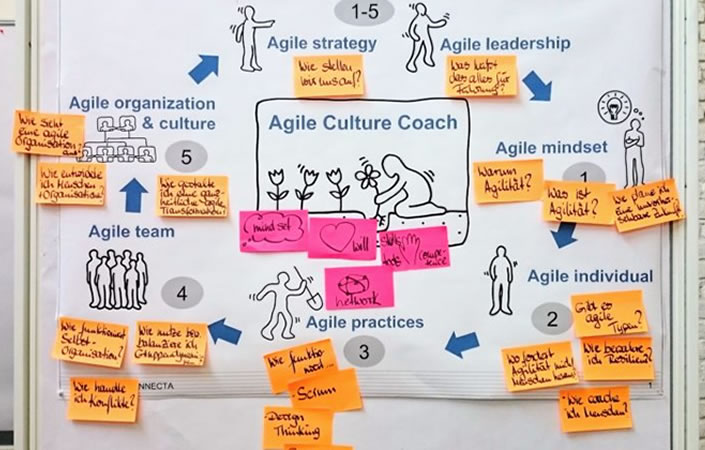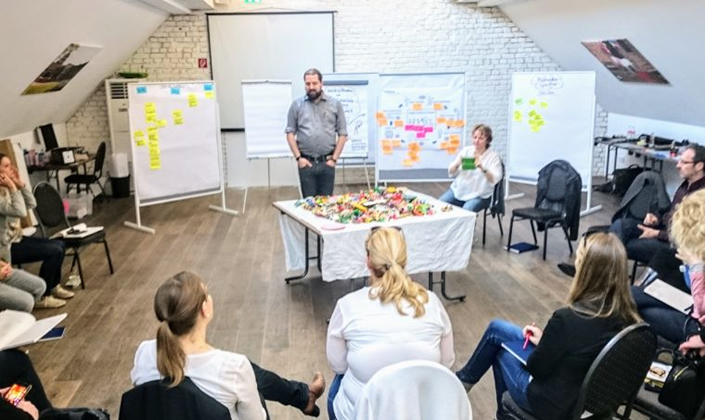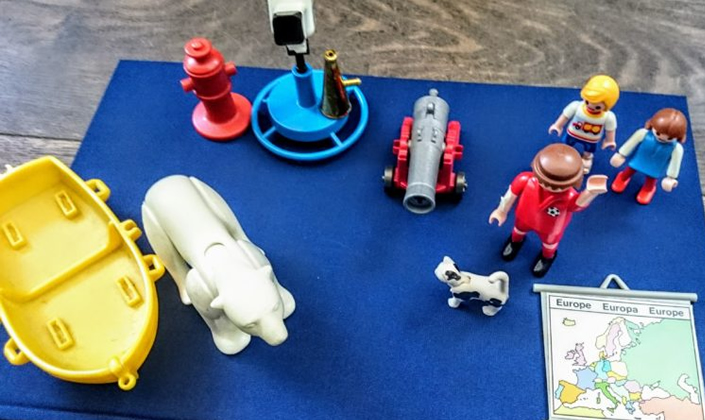12. September 2017

»Agility« and »management control« – that’s a match! Even this year’s large Munich »Controller Congress« agreed when they titled the event »Agile controlling in digital reality: Managing upheavals successfully«, didn’t they? Or is it not a match after all, as some critics raise in discussions time and again? I have a fantastic opportunity: I have been invited to delve deep into the topic with a professional training course to be an »Agile Culture Coach«! These blog contributions will report on my experiences.
This training course takes the form of five modules, which each last several days, over the course of a year: »Agile Leadership and Participation«, »Agility and Personality«, »Agile Methods and Scrum«, »Agile Teams and Conflicts«, »Agile Organization and Culture«. Together with 13 other participants, I am enjoying this training course by and with SYNNECTA, consultants for organizational development and change management in Cologne. It is already the third run of this course: the hosts are visibly proud to be able to name it »the original«.
»Agile Leadership and Participation«
The first three-day-module is titled »Agile Leadership and Participation«. It is a fascinating start which goes far beyond a mere introduction for guidance and terminology. We address »agile strategy« (How to we take position?), »agile leadership« (What does that mean for management?) and »agile mindset« (Why agility? What is agility? How do I plan for an unforeseeable future?)
So, what is »agility«? The views are generally hazy. Our two trainers Renate Standfest and Dr. Johannes Ries are perfectly right to mention that the word »agile« is often even used as an excuse for appointments not kept, responsibilities abused. They make a convincing case, however, that the term has its basis in »valuable thoughts and concepts« that go far beyond »showmanship and bullshit bingo«. It is these notions that give teams, organizations and management a scope for action in the current times, which our trainers describe as a »VUCA situation«.

Our »current times«, dominated as they are by digitalization, political upheaval, climate change, etc. are, as is generally known, described as a »VUCA world«. VUCA comprises »volatility« (instability and fast, ground-breaking change), »uncertainty« (even incalculability), »complexity« and »ambiguity« (without simple cause-and-effect relations, ambiguity is on the fore). »Linear methods« no longer apply in this world of VUCA: so what will work?
How are we to understand »agility«? Out course instructors will not provide a »single, 100 per cent« definition. They note the »dimensions of agility« and recommend the »agile manifesto« as a basis. This »Manifesto for Agile Software Development« (it was signed by 17 persons from the field of programming in 2001) points out several key points:
- they consider »individuals and interactions« more important than processes and tools;
- they deem a »functioning product« more important than extensive documentation;
- they explicitly favour »cooperation with the client« over any (contract) negotiations;
- they expressly consider »reacting to change« more important that following a plan.
The SYNNECTA experts derive 12 principles from this manifesto: client satisfaction, openness for change, iterative development, intensive cooperation, focus on a motivating environment, face-to-face communication, functioning products as a measure of progress, steady speed, technical excellence and good design, simplicity, self-organization and self-reflection. »This list is a good summary of the mindset that is necessary for all agile practices and configurations to work«, states Ries.
Effectuation: means guidance, affordable loss and more
The course focuses on agile practices and methods that facilitate the above-named principles. »Scrum«, for example, is a term that comes from software development and by now has entered further fields. This agile method (it will be treated in depth in the third module of the course) is aimed at reducing the »scale of effort« as far as possible.
»Effectuation« is a concept that particularly catches my interest during this first module of my Agile Coach course. Once again, we are addressing hands-on consequences of the changing world, and in particular our world of work. »The dominant theme here is not ›either or‹, it’s ›as well as‹!«, explains SYNNECTA expert Renate Standfest. »With an uncertain future, where the environment can be changed and the aims negotiated, we’re on perfect ground for effectuation.« We are used to problem-solving by way of »linear causal processes«, but now is the time to recognize the circumstances, coincidences and unplanned events as opportunities and deliberately not draw a line. We are presented with a stimulating list of four principles of effectuation:
- Principle of means guidance: instead of choosing or creating the means and ways to achieve a previously defined goal, this means finding goals and results that are achievable within a given set of means.
- Principle of affordable loss: guide your investment at hand of the affordable loss, not the expected result.
- Principle of circumstances and coincidences: circumstances, coincidences and the unexpected should be used as an opportunity rather than being shut out.
- Principle of agreements and partnerships: to be made with those who are ready to take part.
Module I of my Agile Culture Coach training course is filled to the brim with a plethora of highly interesting input. I am convinced that that’s a match for the world of controlling! There is plenty of thought-provoking content on offer in these first three days alone. I had many, many new insights, from dimensions and principles of agility to effectuation, fascinating methods such as landscaping, the Stacey matrix, daily meetup, etc., and even playful elements like the team-building »marshmallow spaghetti contest« as well as the very personal presentations by the individual course participants at hand of Lego and Duplo bricks.

Hans-Peter Sander
blog.icv-controlling.com
8. July 2015
 The differences between an Indian slum, a Brazilian favela and the banking district in Frankfurt, between a discriminated Roma group and a company department, between a family on benefits and the boardroom members of a DAX enterprise are apparent: poverty v. wealth, powerlessness v. power, underprivileged v. privileged … No business school and no MBA degree will waste even a single thought on people who live in conditions of precarity – how they are and how they deal with their precarious situation. However, I believe that the business sector can learn from these people and the cultures that they have established under extremely averse conditions. After all, slum dwellers, the poor, minorities, outsiders and other fringe groups who have to master their sheer survival day in day out are experts on precarious situations – in other words, they are VUCA experts.
The differences between an Indian slum, a Brazilian favela and the banking district in Frankfurt, between a discriminated Roma group and a company department, between a family on benefits and the boardroom members of a DAX enterprise are apparent: poverty v. wealth, powerlessness v. power, underprivileged v. privileged … No business school and no MBA degree will waste even a single thought on people who live in conditions of precarity – how they are and how they deal with their precarious situation. However, I believe that the business sector can learn from these people and the cultures that they have established under extremely averse conditions. After all, slum dwellers, the poor, minorities, outsiders and other fringe groups who have to master their sheer survival day in day out are experts on precarious situations – in other words, they are VUCA experts.
The VUCA situation is usually perceived like an state of emergency in companies: it cannot be met with the usual management and leadership tools. Although their physical survival is safe, people in companies regard the situation of volatility, uncertainty, complexity and ambiguity to be precarious, because our well-being is firmly attached to stability, security, simplicity and explicitness. I have referred to the cultural philosopher and artist Yana Milev in an earlier blog post. She works on strategies for an emergency design in response to the state of emergency. Philosopher Isabell Lorey also addresses precarity in a completely new manner as an opportunity. Thanks to a great number of case studies, social scientists – foremost among them the cultural anthropologists – have met and are aware of confident experts in really dealing with precarity: people on the fringes, people who are marginalized, nomads, the excluded and other groups. These people have to live with the constant possibility that everything might come to an end by the next day, or at least change radically, and have to be ready for that.
I myself was able as a cultural anthropologist to study survival strategies in the face of a permanent state of emergency on fieldwork with Roma/gypsies in Romania (see Welten Wanderer, 2007). To me, one of the most interesting aspects was their completely different approach to time: the Roma/gypsy groups who I was privileged to meet also lived as marginal people who live for the moment. Michael Stewart, Sophie Day and Evthymios Papataxiarichs used this phrase as the subtitle for their wonderful anthology Lilies of the Field (1998), which draws a non-judgmental and equal portrait of the cultural survival strategies employed by Hungarian Rom, Untouchables in India, London prostitutes and other groups in precarious situations. According to the cultural anthropologists, they live like »lilies of the field« (cf. the bible verse Mt 6:28), who do not worry about tomorrow but are able to act confidently in the here and know while trusting (in God) that the next day will bring opportunities to survive.
As long ago as 1966, Oscar Lewis conducted his enlightening studies on the Culture of Poverty, where he established that people in a permanently precarious situation are particularly focused on the presence, even »forget« how to plan for a future beyond the immediate tomorrow. As I was sitting in clay huts and shacks without water or electricity supply during my own field research and was allowed to participate in the lives of the inhabitants of these shantytowns, I realized how much of this fixation on the present is a matter of self-protection: if you are caught in deepest poverty, thinking of tomorrow will only drive you mad or send you into depression …
Yet this fixation on the present in marginalized groups does not mean that they deliver themselves to the future as submissive victims. They go into the future step by step, »without a plan«, which can be of great advantage to them. There is a remarkable inventiveness to the way in which marginalized persons use bricolage, resourcefulness and improvisation in order to find solutions to problems. At the same time, they focus onkairos moments: opportunities that suddenly arise or come about, that are useful to those who grasp them on the spot and react flexibly to their presence. People on the fringes of society establish intensive relationships based on trust, thereby building tightly woven networks and systems of patronage that act as a safety nets in crises. Even though these groups can often not escape their poverty and precarity in this way, they are still equipped with successful coping strategies in the face of a state of emergency.
Our future-oriented society considers it a lack of planning skill to act out of the moment. However, the experts on precarity are in fact demonstrating an interesting new approach to handling VUCA. In order to perform successfully in a VUCA situation, those in the business world will need the same coping strategies as are used by groups on the fringes and in conditions of precarity in order to secure their survival amid poverty. This hypothesis is supported by the results of research conducted by Professor Saras Sarasvathy from the USA. She researched the behavior of successful businesspeople, far removed from milieus of poverty as they are. Interestingly, she identified quite similar aspects to be factors of success for entrepreneurs. Just like marginalized groups in a state of emergency, successful entrepreneurs will act »out of the present« and without overly narrow, concrete aims in mind »into« a volatile, uncertain, complex and ambiguous future. Sarasvathy called this type of action effectuation; it is in strong juxtaposition to the linear-causal and goal-oriented school of thought that is generally preferred as a logical and goal-driven approach to handling the future.
Like the fringe groups outlined above, successful entrepreneurs also focus on four central Effectual Principles:
1. Means
In linear-causal thought, we set a goal that we want to reach and then conclude from that which means we require in order to achieve that goal. Ideally, we will have some of those means at our disposal, but will still have to generate others in order to reach our goal: We have to collect information, build up competence, create structures, establish contacts … Whoever has ever been involved in a company’s strategy process will confirm how firmly business planning adheres to this route.
All of this makes perfect sense if the one, set goal will remain stable in the long run. In a VUCA situation, however, it is anything but certain that a goal set today will still make sense tomorrow. Today’s effort invested in a future-oriented establishment of means can turn out to have been senselessly wasted energy by tomorrow.
An effectuating venture, on the other hand, proves to be VUCA resilient, as it generates future (options) from existing present potential. Effectuating planning does not set off from the one goal that is to be reached in the future, but from the means that are available in the present. All existing means together make up the potential from which a range of possible goals can be identified. Strength-oriented gathering of potential sets off from the plenitude that actually exist rather than from a scarcity seen from a future point of view. This plenitude allows the entrepreneur to start acting today.
2. Affordable Loss
The principle of affordable loss concerns finance and investment planning. In linear-causal thought, we create an (imaginary) business plan, in which we calculate a notion of the future income situation. We set certain conditions under which we will be able to make a (maximum) profit with (minimum) effort. This means it is often necessary to invest in the beginning, as the means to reach our goal still have to be generated (see point 1). In expectation of a large profit, which also requires a large investment, it makes sense to borrow money from others for the start. If our business plan is good, we can calculate the ROI point exactly: that moment in the future when the (assumed) earnings will balance the (assumed) investment and from which time onwards we will make a profit.
What happens, though, when a VUCA situation makes the future ever less calculable? A financial plan that makes assumptions on the future, and then bases large investments for large profits on this plan, is an increasingly risky enterprise. If the future is uncertain, the (assumed) earnings are also not certain. Debts make us less free and steal the flexibility we need to react to new situations speedily.
An effectuating finance and investment plan is contrary to linear-causal thought: it sets off from the bird in hand and does not strive for the two in the bush. That means, planning is focused on the loss that can be afforded in the present and not on the profit that is hoped for in the future. As planning includes the VUCA-aware knowledge that the venture can also fail, the entrepreneur asks: how much money can I afford to lose at the moment in order to realize a venture? The investment therefore never crosses the line to becoming dangerous. If a venture requires more capital than is available to the entrepreneur, the effectuating entrepreneur will not enter a debt dependency. Instead, they will find trustworthy partners (also see point 4), who are willing (also without endangering themselves) to join the investment and in return enjoy a proportional share of the profits. In this way, effectuation shares investment risks and safeguards financial survival through cooperation.
3. Leverage Contingencies
These first two principles alone ought to add up to the way in which the two schools of thought approach circumstances and coincidences. As linear-causal thought sets a firm goal and follows an exact plan of means attainment and financial investment, it must attempt to control the circumstances that will actually arise and avoid surprises. Every coincidence can ruin a venture, as it can cause deviance from the plan. When the real circumstances of the future turn out to be different from what had been assumed, the goal attainment plans will have to be adapted; in the worst case the goal will even have to be shifted. In an earlier blog post, I have already outlined the basics of this school of thought based on the Prussian warfare theorist Clausewitz.
However, VUCA situations are making it ever more difficult to control the circumstances of the future. Rising volatility and increasing complexities make it more and more probable that we will be surprised by coincidences and therefore will be facing realities tomorrow that will differ from what we were able to assume today. It is therefore much more useful to chose an opportunistic (in the positive sense) tactical approach in a VUCA situation, as I outlined in the above-mentioned blog post at hand of the ancient Chinese military strategist Sun Tsu.
Sun Tsu described an effectuating approach to strategy as long ago as two and a half millenia before now: the strategist needs to open up to surprises, always being in charge of the now and able to make decisions for future actions out of the actual moment. Entrepreneurs who set off from the extant means and do not focus on one goal only, but are able to aim for a range of options in a wider spectrum of goals, and who at the same time are able to react flexibly without debt obligations and fears of being ruined, will be (largely) independent of the circumstances in which they will find themselves in the future. This can make coincidence a possibility. In this context, a changed situation is not a crisis of the plan, but always an opportunity for further action (cf. the double meaning of the word in Chinese).
4. Co-Creation Partnerships
The linear-causal approach asks: who do I need in order to realize my venture? We search for the missing piece to our venture in others. In doing so, we want to be able to define exactly what we need our partner for. In companies, this very aspect is enacted in often endless discussions about interfaces. As we are obliged to follow a clearly defined goal »from above«, we have »a right« to be supported by other parties, who are not part of the process. If we do not receive this support, we make demands that are accompanied by the frequently serious and debilitating arguments in a silo culture.
In VUCA situations, dealing with others becomes a key skill. This is why I suggested interactivity as one of the six basic stances of successful VUCA AIKIDO. When all plans and ventures collapse, it is useful to have a broad web of trustworthy relationships to catch and hold you in an emergency.
An effectuating entrepreneur will not try to define the interfaces but create wide junctions. Such entrepreneurs will look for people they value, with whom they can establish firm relationships of trust. Sarasvathy visualized this approach with the image of a patchwork quilt: a so-called »cracyquilt« that is sewn together out of firmly connected individual patches to make one stable surface. To effectuating entrepreneurs, the central question is: Who do I get on well with, who can I trust and who is ready to take part? A web of trustworthy partnerships is one of the central means for effectuating out of the present into the future. It magnifies individual potential and at the same time offers security amid the uncertainties of the VUCA world.
Experts on precarity possess a basic cultural skill: living in the moment. It will now be apparent that there are advantages of effectuating action to the economic world: While linear-causal thought always requires a future that can be planned as well as a stable environment, the VUCA situation offers an ideal context for effectuation. The effectuating mindset does not consider VUCA to be a problem, but an opportunity. That which is there already opens a wide range of options, possibilities and paths. The future is always open – it is and remains our choice what we will make of it out of this moment …
Johannes Ries




 The differences between an Indian slum, a Brazilian favela and the banking district in Frankfurt, between a discriminated Roma group and a company department, between a family on benefits and the boardroom members of a DAX enterprise are apparent: poverty v. wealth, powerlessness v. power, underprivileged v. privileged … No business school and no MBA degree will waste even a single thought on people who live in conditions of precarity – how they are and how they deal with their precarious situation. However, I believe that the business sector can learn from these people and the cultures that they have established under extremely averse conditions. After all, slum dwellers, the poor, minorities, outsiders and other fringe groups who have to master their sheer survival day in day out are experts on precarious situations – in other words, they are VUCA experts.
The differences between an Indian slum, a Brazilian favela and the banking district in Frankfurt, between a discriminated Roma group and a company department, between a family on benefits and the boardroom members of a DAX enterprise are apparent: poverty v. wealth, powerlessness v. power, underprivileged v. privileged … No business school and no MBA degree will waste even a single thought on people who live in conditions of precarity – how they are and how they deal with their precarious situation. However, I believe that the business sector can learn from these people and the cultures that they have established under extremely averse conditions. After all, slum dwellers, the poor, minorities, outsiders and other fringe groups who have to master their sheer survival day in day out are experts on precarious situations – in other words, they are VUCA experts.